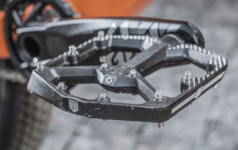OP have you ever properly set up your suspension for sag? Just randomly adding psi is kind of a shot in the dark. This is very important as it takes your body weight into the equation and by adjusting the shocks accordingly at least you know you are at the proper level for your needs. Any FS bike, and even just a front shock can benefit from doing this and sticking to it as it will result in the least amount of bb drop during compression to start out with. Plenty of info online about the procedure.
All the other tricks mentioned above like shorter cranks and more air in your tires can help for sure but there is nothing better for avoiding pedal strikes than reading the terrain you are riding and avoiding strikes via timing your cranks to avoid any obstacles that might result in a strike. This can mean anything from just stopping pedaling altogether with the cranks in a horizontal position to actually ratcheting or slowing down your cranks that will keep your forward momentum going while avoiding what you think they might hit.
Dependent on the sensitivity of your PAS this can be somewhat awkward however as when you stop constant rotation it may shut down and have to restart when pressure is reapplied. I have found though, with a torque assist PAS at least, that if you slightly drag the front brake you can keep enough pressure on the pedals to keep the PAS active while slowing down your crank rotation to avoid strikes, at least of visible objects. As soon as the danger is past you let go of the brake and as you have kept the PAS active off you go.


